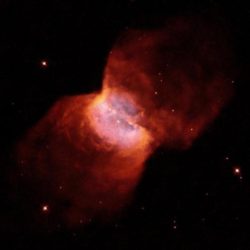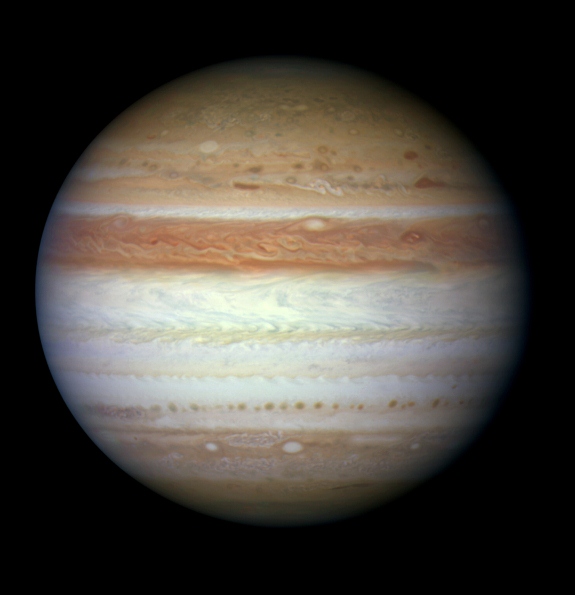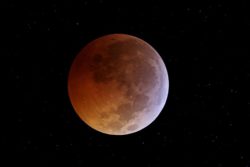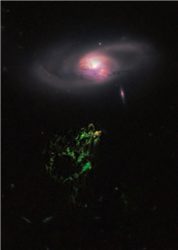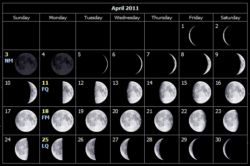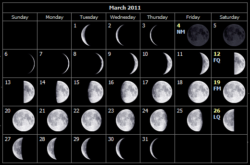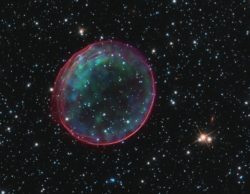Astronomy Picture of the Week – NGC 2346 Planetary Nebula
NGC 2346 is a planetary nebula which is ejected from Sun-like stars which are near the ends of their lives. It is remarkable because its central star is a very close pair of stars, orbiting each other every 16 days. The nebula lies about 2,000 light-years away from us, and is about one-third of a light-year in size.
Astronomy Picture of the Week – Jupiter as seen by Hubble
This image of Jupiter was taken by NASA's Hubble Space Telescope on June 7, 2010. Image Credit: NASA, ESA, M.H. Wong (University of Califoria, Berkeley), H.B. Hammel (Space Science Institute, Boulder, Colo.), A.A. Simon-Miller (Goddard Space Flight Center), and…
Astronomy Picture of the Week – NGC 6782
This spiral galaxy is called NGC 6782. When seen in visible light, it exhibits tightly wound spiral arms that give it a pinwheel shape similar to that of many other spirals. However, when viewed in ultraviolet light with NASA's Hubble Space Telescope, its shape is startlingly different.
Monthly Stargazing Calendar for June 2011
On June 15 there will be a total lunar eclipse which will be visible throughout most of South America, Europe, Africa, Asia, and Australia. Unfortunately it will not be visible in North America. Here is a map with the exact areas where the lunar eclipse can be witnessed…
Astronomy Picture of the Week – Space Oddity
This unusual ghostly green blob of gas appears to float near a normal-looking spiral galaxy in the image taken by NASA's Hubble Space Telescope. The bizarre object, dubbed Hanny's Voorwerp (Hanny's Object in Dutch), is the only visible part of a 300,000-light-year-long streamer of gas stretching around the IC 2497 galaxy.
Astronomy Picture of the Week – Spiral Galaxy NGC 2841
This view of the majestic disk of stars and dust lanes of the spiral galaxy NGC 2841 was taken by NASA’s Hubble Space Telescope in 2010. The galaxy lies 46 million light-years away in the constellation of Ursa Major. Credit: NASA, ESA, and the Hubble Heritage (STScI/AURA)-ESA/Hubble Collaboration Acknowledgments: M. Crockett and S. Kaviraj (Oxford University, UK), R. O’Connell (University of Virginia), B. Whitmore (STScI), and the WFC3 Scientific Oversight Committee
Monthly Stargazing Calendar for April 2011
The Lyrids are an average meteor shower with about 20 meteors per hour at their peak on April 21 and 22. These meteors can produce bright dust trails that last for several seconds. The shower is most spectacular during the peak on April 21 and 22, but some meteors can still be spotted from April 16 to 25. The meteors will be radiating from the constellation of Lyra after midnight.
Astronomy Picture of the Week – Mars as seen by Hubble
This is one of the best photos of Mars ever taken from Earth or Low Earth Orbit. NASA's Hubble Space Telescope took this close-up of the red planet Mars when it was just 88 million kilometers away. This color image was assembled from a series of exposures taken within 36 hours of the Mars closest approach…
Astronomy Picture of the Week – Spiral Galaxy NGC 3982
This spiral galaxy, called NGC 3982, looks similar to our own galaxy but it is much smaller. NGC 3982 spans about 30,000 light-years which makes it roughly one-third of the size of the Milky Way galaxy. It is located about 68 million light-years away in the constellation Ursa Major. This image is composed of pictures taken by the Hubble Space Telescope’s Wide Field Planetary Camera 2 (WFPC2), the Advanced Camera for Surveys (ACS), and the Wide Field Camera 3 (WFC3) between March 2000 and August 2009. Image Credit: NASA, ESA, and the Hubble Heritage Team (STScI/AURA)
Monthly Stargazing Calendar for March 2011
This month, on the 20th, an equinox will occur. The Sun will shine directly on the equator and there will be nearly equal amounts of day and night throughout the world.
Astronomy Picture of the Week – Whirlpool Galaxy
This image of the spiral galaxy M51, dubbed the Whirlpool Galaxy, was taken by NASA’s Hubble Space Telescope. M51 is a typical spiral galaxy which includes graceful, curving arms, pink star-forming regions, and brilliant blue strands of star clusters. It is located at a distance of approximately 31 million light-years from the Milky Way Galaxy in the constellation Canes Venatici. It is one of the most famous galaxies in the sky. M51 can easily be observed by amateur astronomers, and may even be seen with binoculars. Image Credit: NASA, ESA, S. Beckwith (STScI), and the Hubble Heritage Team (STScI/AURA)
Astronomy Picture of the Week – Supernova Bubble Resembling Holiday Ornament
This image was made by combining data from two of NASA's Great Observatories: the Hubble Space Telescope and the Chandra X-ray Observatory. The supernova remnant, cataloged as SNR 0509-67.5, is the result of a type Ia supernova. It is located in the Large Magellanic Cloud (LMC), a small galaxy about 160,000 light-years from Earth.

